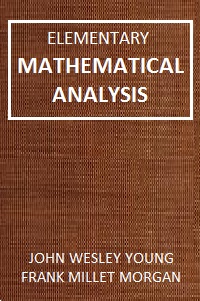Elementary Mathematical Analysis by John Young, Frank Morgan - PDF

About this book :-
"Elementary Mathematical Analysis by John Wesley Young and Frank Millett Morgan" is a classic textbook designed to introduce students to the fundamentals of "mathematics". It provides a clear, structured approach to core topics, making complex ideas accessible for learners at the undergraduate level. The book emphasizes logical reasoning and precision, ensuring readers build a strong foundation in "calculus" and related concepts.
The text covers essential areas such as limits, continuity, derivatives, integrals, sequences, and series, providing numerous worked examples to illustrate each concept. Exercises at the end of chapters encourage practical application and deepen understanding of "real analysis" principles. Young’s systematic style allows students to progress from basic concepts to more advanced topics, bridging the gap between elementary calculus and higher-level mathematical study.
Ideal for both students and educators, this treatise remains a valuable reference for anyone pursuing a solid understanding of "mathematics". Its focus on clarity, rigor, and structured presentation makes it suitable for self-study, classroom use, or as a historical insight into early 20th-century approaches to "real analysis" and "calculus". Young’s work continues to be recognized as an enduring guide for building analytical thinking and problem-solving skills.
Book Detail :-
Title:
Elementary Mathematical Analysis by John Young, Frank Morgan - PDF
Publisher:
The Macmillan Company
Year:
1917
Pages:
582
Type:
PDF
Language:
English
ISBN-10 #:
9391270638
ISBN-13 #:
978-9391270636
License:
Public Domain Work
Amazon:
Amazon
About Author :-
The author
John Wesley Young
(1879–1932) was an influential American mathematician and educator known for his contributions to "mathematics" education. He specialized in "real analysis" and "calculus", creating textbooks that made complex concepts clear and accessible to students. Young’s works, including "Elementary Mathematical Analysis", emphasized logical reasoning, structured learning, and problem-solving. His approach bridged foundational theory with practical examples, helping learners develop strong analytical skills. Today, his textbooks remain valued references for students and educators seeking a solid understanding of "calculus", "real analysis", and classical "mathematics" principles.
Book Contents :-
PART I. INTRODUCTORY CONCEPTIONS
1. Functions and Their Representation
2. Algebraic Principles and Their Geometric Connection
PART II. THE ELEMENTARY ALGEBRAIC FUNCTIONS
3. Applications of Quadratic Functions
4. Quadratic Equations
5. The Cubic Function; The Function (x^n) (n a positive integer)
6. The Trigonometric Functions
7. Trigonometric Relations
8. The Logarithmic and Exponential Functions
9. Numerical Computation
I. Errors in Computation
II. Logarithmic Solution of Triangles
III. The Logarithmic Scale and the Slide Rule
IV. Logarithmic Paper
PART III. APPLICATIONS TO GEOMETRY
10. The Straight Line
11. The Circle
12. The Conic Sections
13. Polar Coordinates
14. Parametric Equations
PART IV. GENERAL ALGEBRAIC METHODS — THE GENERAL POLYNOMIAL FUNCTION
15. Miscellaneous Algebraic Methods
16. Permutations, Combinations, Probability, and the Binomial Theorem
17. Complex Numbers
18. The General Polynomial Function: Theory of Equations
19. Determinants
PART V. FUNCTIONS OF TWO VARIABLES — SOLID ANALYTIC GEOMETRY
20. Linear Functions; The Plane and Straight Line
21. Quadratic Functions; Quadric Surfaces
Tables
Powers and Roots
Important Constants
Logarithms (4-place)
Four-place Trigonometric Functions
Similar
Mathematical Analysis
Books